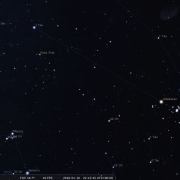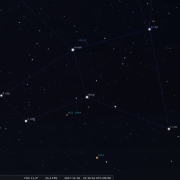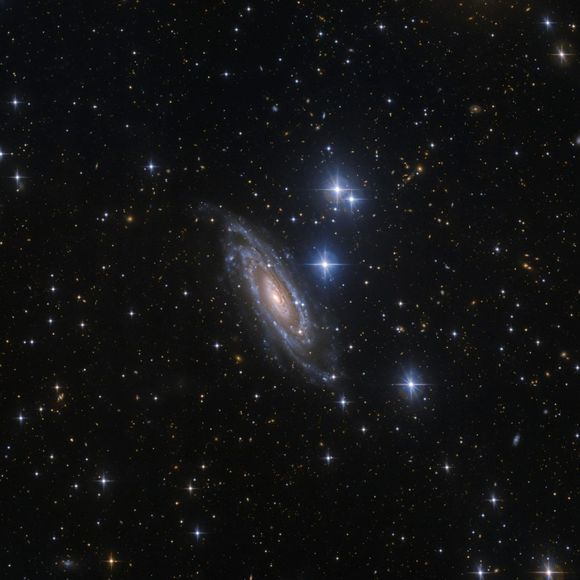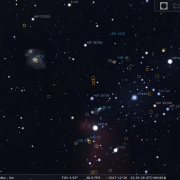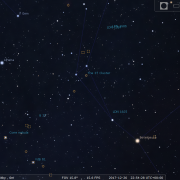Continuing our new feature, we take a brief look at this month’s selection of objects of particular interest crossing the meridian line.
Star: 119 Tauri (CE Tau)
Eye/Binoculars/Scope, Easy/Medium
The Ruby star in the constellation Taurus.
119 Tauri has a spectral class of M2 and is classified as a semi irregular variable star ranging in brightness from magnitude +4.23 to +4.54 with a period of 165 days. At approximately 1,800 light years from Earth CE Tau is close enough that its distance can be determined accurately by parallax and therefore its actual diameter can also be determined. It has a diameter just over 600 times our Sun, this equates to approximately 520 million miles!
With a high colour index, it is one of the reddest naked eye stars in the night sky second only to Mu Cephei. Naked eye, binoculars or scope – Due south Jan 17th – just before 22:00h
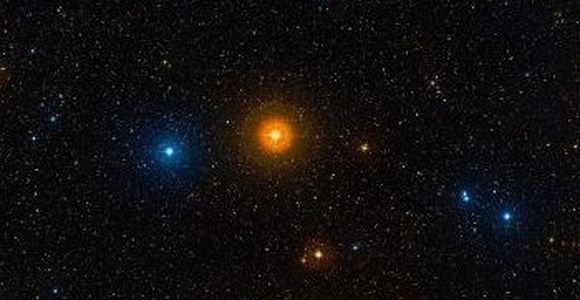
Star: 119 Tauri (CE Tau) (Image Credit: Sloan Digital Sky Survey)
Galaxy: NGC 1964
Telescope, Medium/Challenge
There are no relatively conspicuous galaxies of note crossing the south meridian line, those that do are quite difficult, inconspicuous wisps (unless you are imaging or have a very large backyard scope). Perhaps try hunting for NGC 1964, a barred spiral galaxy in the constellation Lepus, located crouching below Orion.
This 10.7 mag galaxy lies 65 million light years away from Earth and is approximately 100,000 light years across. At its centre lies a super massive black hole, with estimated mass of 2.5 million solar masses. The galaxy features two tightly wound inner spiral arms within a disk with high surface brightness and two outer, more open spiral arms that originate near the inner ring. NGC 1964 is the main galaxy in a group of galaxies, known as NGC 1964 group, which also includes the galaxies NGC 1979, IC 2130 and IC 2137.
Look for it January 15th, 21:55h due south 1.5 degrees lower left of beta leporis (Nihal) and fractionally left of a mag 9.65 orange star Do not mistake it for the globular cluster M79, which lies well south of Nihal
Nebula: Messier 78 (or NGC 2068)
Small Telescope, Medium
A reflection nebula in the constellation Orion. Again we shall steer clear of the obvious –M42 Orion nebula, and instead take a look at M78. This was discovered by Pierre Méchain in 1780 and was included by Charles Messier in his catalogue. M78 is the brightest diffuse reflection in the sky and lies in a group of nebulae that include NGC 2064, NGC 2067 and NGC 2071. This group belongs to the Orion Molecular Cloud Complex located 1,600 light years distant from Earth.
M78 is easily found in small telescopes as a hazy patch which also involves two stars of 10th magnitude. These two stars, HD 38563A and HD 38563B, are responsible for making the cloud of dust in M78 visible by reflecting their light The nebula is pretty easy to find as it is located only about 2 degrees north and 1.5 degrees east of Alnitak, the easternmost star of Orion’s Belt. Due south Jan 16th – 22:00h.
Cluster: The 37 cluster (NGC 2169)
Binoculars/Telescope, Easy/Medium
It would have been very easy to go for the Pleiades, however I'd like to highlight an object you may not have heard of, yet it certainly deserves scrutiny.
Possibly discovered by Giovanni Batista Hodierna before 1654, it was certainly observed by William Herschel on October 15, 1784. At moderate magnification, you’ll see NGC 2169 comprised about 15-20 stars of 7th magnitude or fainter arranged in two groups, both about 1/10 of a degree across. One group contains 6-7 stars and the other perhaps 10-12 stars. It is the arrangement of these stars that is so striking. Nicknamed "The '37' Cluster" due to its resemblance to the numerals "37". The larger group forms the letter “3” and the smaller group forms the letter “7”.
NGC 2169 is about 3,500 light years from Earth and is just 8 million years old. Due south Jan 22nd at 22:00h
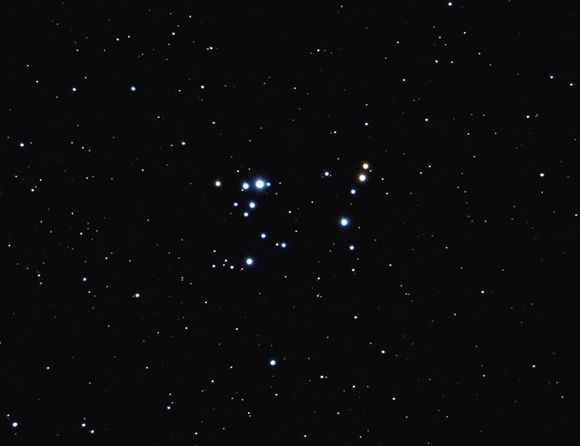
The 37 cluster (NGC 2169). (Image Credit: ESO / Igor Chekalin)
- Log in to post comments

